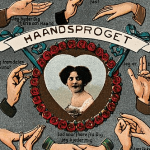 Weird Stuff
Weird Stuff  Weird Stuff
Weird Stuff  Our World
Our World 10 Ways Your Christmas Tree Is More Lit Than You Think
 Movies and TV
Movies and TV The 10 Coolest Stars to Set Sail on The Love Boat
 History
History 10 Things You Didn’t Know About the American National Anthem
 Technology
Technology Top 10 Everyday Tech Buzzwords That Hide a Darker Past
 Humans
Humans 10 Everyday Human Behaviors That Are Actually Survival Instincts
 Animals
Animals 10 Animals That Humiliated and Harmed Historical Leaders
 History
History 10 Most Influential Protests in Modern History
 Creepy
Creepy 10 More Representations of Death from Myth, Legend, and Folktale
 Technology
Technology 10 Scientific Breakthroughs of 2025 That’ll Change Everything
 Weird Stuff
Weird Stuff Ten Bizarre Facts About The Doge Meme
 Our World
Our World 10 Ways Your Christmas Tree Is More Lit Than You Think
 Movies and TV
Movies and TV The 10 Coolest Stars to Set Sail on The Love Boat
Who's Behind Listverse?

Jamie Frater
Head Editor
Jamie founded Listverse due to an insatiable desire to share fascinating, obscure, and bizarre facts. He has been a guest speaker on numerous national radio and television stations and is a five time published author.
More About Us History
History 10 Things You Didn’t Know About the American National Anthem
 Technology
Technology Top 10 Everyday Tech Buzzwords That Hide a Darker Past
 Humans
Humans 10 Everyday Human Behaviors That Are Actually Survival Instincts
 Animals
Animals 10 Animals That Humiliated and Harmed Historical Leaders
 History
History 10 Most Influential Protests in Modern History
 Creepy
Creepy 10 More Representations of Death from Myth, Legend, and Folktale
 Technology
Technology 10 Scientific Breakthroughs of 2025 That’ll Change Everything
10 Fascinating Facts About Accidental Medical Discoveries
Over the past 200 years, revolutionary advancements in medicine have allowed us to combat some of the deadliest diseases and improve public health. Better hygiene, healthier lifestyles, and medical advancements have significantly increased life expectancy worldwide. These breakthroughs were led by visionary doctors who overcame monumental odds through curiosity, genius, and determination.
The insatiable curiosity and open-mindedness of these remarkable doctors led them to serendipitous discoveries that expedited the treatment, management, and prevention of many deadly diseases and saved millions of lives. Here are some fascinating facts about accidental medical discoveries.
Related: 10 Ancient Fertility Treatments You Wouldn’t Want to Use Today
10 ED Drug Arose from Failed Heart Drug Trial
Erectile Dysfunction (ED), a condition that affects men based on ten percent of their age (e.g., 60% of men in their 60s and so on), was rarely talked about until the discovery of the miraculous “little blue pill” or Viagra. Before Viagra, the battle against impotence was waged using monkey testicle implants, tiger penis soup, and constrictive rings—none of which yielded results.
Pharmaceutical company Pfizer was testing a heart drug that relaxes smooth muscles. After a series of weak initial results, the trial was to be discontinued. The report from a fortuitous last-ditch attempt, as reported by Dr. Nick Terret, a lead chemist on the trial team, read: “Some muscle ache, seen some headaches and some gastrointestinal disturbance, oh yes, and some of the nurses noticed erections.”
An astute researcher on the trial team realized the potential of the accidental discovery, resulting in 21 highly successful trials of what became Viagra—a drug that works by improving blood flow to the penis when the user is aroused. The accidental discovery was a massive win for the manufacturer and… er, humanity.[1]
9 Child Inoculated with Cowpx to Fight Another Disease
Smallpox was a terrible disease that killed 400,000 people every year in Europe alone in the early 18th century. The deadly disease killed a third of the infected adults and eight out of 10 infants. The symptoms included body aches, high fever, a sore throat, headaches, difficulty breathing, and disfiguring pustules filled with pus all over the body. Those who survived the disease were left pockmarked and disfigured.
In 1796, Edward Jenner, a British doctor, accidentally discovered that people who had contracted cowpox, a harmless disease, never got smallpox. Jenner inoculated an eight-year-old child with the pus from the cowpox lesions of a milkmaid. After the boy recovered, Jenner inoculated the boy with the pus from a smallpox blister without knowing for sure what would happen. The chilling experiment, ethically questionable by today’s standards, seemed to work. The boy did not develop smallpox.
Jenner began vaccinating people at his house on Sundays. Within 20 years, the smallpox vaccine had saved millions of lives. This deadly disease was completely eradicated in 1979.[2]
8 Pancreas Removal in Dogs Shed Light on Diabetes Treatment
Diabetes, in its severe form, was a horrible disease that often struck children. Patients expelled excess sugar through urine, lost weight, fell into a coma, and eventually died.
Initially, the body’s inability to process carbohydrates was thought to be a liver or stomach disorder. German researchers Oskar Minkowski and Josef von Mehring discovered in 1889 that dogs that had their pancreas removed immediately became diabetic and died shortly afterward. This led to the conclusion that it was the pancreas that produced the substance essential to prevent diabetes.
Several attempts were made in the early 20th century to prepare pancreatic extracts that could lower blood glucose, but it proved challenging. In 1922, Fredrick Banting and Charles Best injected a pancreatic extract into the body of a 13-year-old boy on the brink of death from diabetes. Although the first attempt did not work, later injections showed remarkable improvement, and the boy recovered. The revolutionary discovery of insulin has paved the way for the next generation of research into diabetes.[2]
7 One Woman’s Cells Helped Finetune the Pap Smear
George Nicholas Papanicolaou is best known for creating the Papanicolaou test, commonly known as the Pap Smear, which helps in the early detection of cervical cancer. Researchers estimate that nearly 100 women died of cervical cancer every day in the United States in the early 20th century. Cervical cancer grows stealthily and slowly. By the time the symptoms appear, the cancer has often spread to the lungs, bones, or liver. The women become jaundiced, cough up blood, suffer fractures, and then die.
When George Papanicolaou discovered a way to extract vaginal fluid from guinea pigs to determine the animal’s health and reproductive status, he wondered whether this could work with humans. His wife Mary willingly became his test subject and gave 7600 samples over 21 years. Papanicolaou collaborated with Dr. Herbert Traut to show that normal and abnormal smears taken from the cervix and the vagina could be studied under the microscope and correctly classified.
In 1960, the American Medical Association began recommending women be screened with the Pap test. The simple procedure quickly became the gold standard in testing for cervical cancer and resulted in a significant decline in deaths related to cervical cancer.[4]
6 From Cathode Lights Rays to X-Rays
In 1895, German scientist Wilhelm Röntgen tried to determine if cathode light rays could pass through glass. While working in his lab, he noticed a glow projecting onto a nearby screen when the cathode tube was covered up. When Röntgen placed his hand in front of the tube, he was surprised to see his bones in the image projected on the screen. Through experimentation, he found that the light could pass through most substances but leave shadows of solid objects.
Röntgen called them X-rays. He also found that X-rays could pass through the human body, rendering the bones visible. In no time, the clinical use of X-rays flourished. Within a year, X-rays were used to locate fractures, kidney stones, and swallowed objects. Röntgen was awarded the first Nobel Prize for Physics in 1901.[5]
5 Blood Thinner Discovery Tied to Bleeding Bovines
In 1933, a farmer showed up in a lab at the University of Wisconsin in Madison with a milk jug full of blood, a dead cow, and a pile of moldy hay. Several of the farmer’s cows had died from internal bleeding after eating the moldy hay.
Biochemistry professor Karl Paul Link and his student assistant recognized the signs of sweet clover disease, which develops when cattle eat wet, spoiled clover hay. In 1939, Link and his team isolated a compound in the hay that prevented cow blood from clotting. The researchers recognized the potential of an anti-coagulant in preventing dangerous blood clots in humans.
After years of research, Warfarin was first launched in the market in 1948 but only as a rat poison. Link’s team developed a water-soluble version, which was approved for human use in 1954. Warfarin became a widely prescribed blood thinner that helped millions of patients by lowering the risk of heart attack and stroke.[6]
4 Preventing Pregnancy with a Vegetable?
In the mid-20th century, the quest for safe and affordable oral contraception was underway. Margaret Sanger, an ardent supporter of women’s rights, drove the research and development of one of the most impactful medical breakthroughs of the 20th century—the pill. The lion’s share of the research funding was provided by Katharine Dexter McCormick, Sanger’s close collaborator and supporter of women’s rights.
When Russel Marker discovered that generations of Mexican women had been eating a certain wild yam—the Barbasco root—for contraception, the research for the pill became possible. Dr. Gregory Pincus extracted progestin from the yams and combined it with estrogen in the right proportion to create the birth control pill.
The first oral contraceptive was approved by the Food and Drug Administration in 1960. Since then, 300 million women worldwide have used the pill safely to achieve reproductive freedom.[7]
3 Discovering Penicillin from a Moldy Dish
In 1928, Scottish doctor Alexander Fleming was investigating influenza in his lab. After returning from a month-long holiday, Fleming discovered that a culture of the bacteria Staphylococcus aureus, which he was studying, had been destroyed by a mold growing in the petri dish.
The mold, which was categorized as genus penicillium, was lethal to the bacteria. Fleming discovered that the mold could kill many bacteria that cause infections in humans and animals. This led to the discovery of the first antibiotic, penicillin. For his work, which has saved countless lives, Alexander Fleming was awarded the Nobel Prize for medicine in 1945. [8]
2 Wrong Part = Medical Breakthrough
A pacemaker is a small, battery-powered device that regulates a slow or irregular heartbeat by sending electric pulses to the heart. In the 1950s, William Greatbatch was working on an oscillator to record heart sounds. When he incorrectly assembled the contraption by installing a resistor with the wrong resistance into the unit, it began to give off a steady electric pulse.
Greatbatch realized that the small device could regulate the human heart. After two years of refinement, the first pacemaker was implanted in humans in 1960. Greatbatch also invented a corrosion-free lithium battery to power the pacemaker. Greatbatch was a great inventor who said, “Nine things out of 10 won’t work. The 10th one will pay for the other nine.” As of his death in 2011, Greatbatch had been awarded 325 patents.[9]
1 Organ Transplant Succes Due to Understanding Immune Response
Organ transplants save millions of lives worldwide. In the 1950s, doctors were struggling to successfully transplant a kidney. These early patients started with a good recovery but soon succumbed.
In Great Britain, Peter Medawar had been studying the topic of organ rejection. Based on his experience as a wartime surgeon, Medawar concluded that the body’s rejection of skin grafts from another person—a foreign tissue—was indeed an immune response. This opened the possibility of organ transplant between genetically non-related patients using immunosuppressants. At this time, a successful kidney transplant between monozygotic twins had been performed by Joseph Murray. As identical twins, the organ did not appear foreign to the patient’s body, which did not reject it.
Medawar’s discovery made organ transplants possible for genetically non-related patients. The first kidney transplant between genetically non-related patients was done using immunosuppression in 1963. Liver, heart, and pancreas transplants were successfully performed in the late 1960s.[10]








